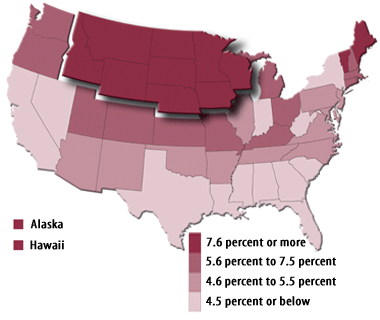|
One job isn’t enough for some people. Data from the U.S. Bureau of Labor Statistics (BLS) show that in 2006, 31 States and the District of Columbia had multiple jobholding rates higher than that of the national average, and 19 States had lower rates.
Overall, 5.2 percent of workers had more than one job in 2006. This rate was slightly below the 2005 rate of 5.3 percent but much lower than the 1996 rate of 6.2 percent.
As the map shows, Southern States generally had a lower multiple jobholding rate than Northern States. Nebraska and South Dakota had the highest multiple jobholding rates (9.9 percent), and Georgia and West Virginia had the lowest rates (3.5 percent).
BLS defines a multiple jobholder as an employed person who had either two or more wage and salary jobs at the same time, was self-employed and also held a wage and salary job, or was an unpaid family worker who also held a wage and salary job.
Data here come from the Current Population Survey. For more information on this study, contact BLS Local Area Unemployment Statistics Information and Analysis, 2 Massachusetts Avenue NE., Suite 4675, Washington, D.C. 20212; call (202) 691-6392; or read the article in
the September 2007 issue of the Monthly Labor Review, available online at
www.bls.gov/opub/mlr/2007/09/rgtrends.pdf.

|



